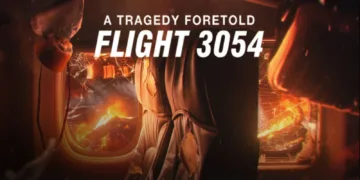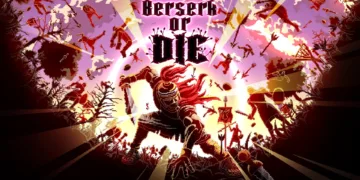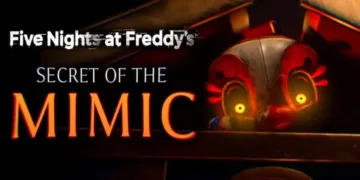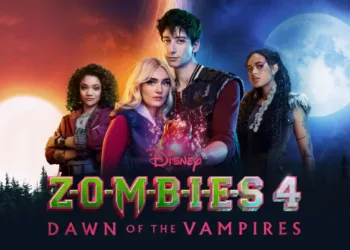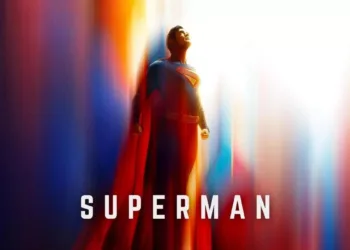Disney’s Zombies franchise has become an unexpected cultural phenomenon, transforming from a modest 2018 television movie into a four-film series that reflects the shifting landscape of American teen entertainment. Paul Hoen’s continued stewardship of this universe demonstrates how Disney Channel Original Movies have adapted to serve both nostalgic audiences and new viewers across international markets.
Zombies 4: Dawn of the Vampires finds protagonists Zed and Addison navigating their post-high school lives, their planned summer camps derailed by a supernatural crisis involving warring vampire and daywalker factions. This premise serves as both narrative device and cultural metaphor, exploring how American coming-of-age stories have evolved to address increasingly complex themes of identity and belonging. The film’s bloodfruit conflict—a resource struggle that splits ancient allies—mirrors contemporary anxieties about environmental scarcity and inherited conflicts that resonate across cultures.
The franchise’s maturation reflects broader changes in how American entertainment addresses young adult audiences. Where earlier entries embraced pure Disney Channel formula, this fourth installment signals a transition toward more sophisticated storytelling that acknowledges its audience’s growth. This evolution parallels similar shifts in global teen media, from K-pop’s increasing narrative complexity to Latin American telenovelas’ younger demographic targeting. The film functions as both continuation and potential torch-passing moment, suggesting Disney’s recognition that successful franchises must evolve or risk cultural irrelevance.
Narrative Architecture and Cross-Cultural Storytelling Patterns
The film’s structural approach reveals fascinating tensions between American individualism and collectivist storytelling traditions. Zed and Addison’s journey from college students to summer camp counselors follows familiar Western narrative patterns of personal growth through service to others. However, their displacement from central protagonists to mediating figures reflects storytelling approaches more common in ensemble-driven narratives found in Japanese anime or European folklore traditions.
The vampire/daywalker conflict draws from global supernatural traditions while maintaining distinctly American characteristics. Unlike European vampire mythology rooted in aristocratic decay or Eastern European folklore about protective spirits, these factions represent inherited prejudice without clear moral hierarchy. The Romeo and Juliet dynamic between Victor and Nova adapts Shakespeare’s cross-cultural appeal while filtering it through Disney’s optimistic worldview. This adaptation process demonstrates how American entertainment continues to globalize classical themes while maintaining domestic accessibility.
The film’s pacing struggles reveal inherent tensions in franchise storytelling. The need to service existing character arcs while introducing new mythology creates narrative overcrowding that American audiences might recognize from Marvel’s recent output, yet international viewers familiar with longer-form serialized storytelling might find more digestible. The transparent torch-passing attempt reflects American entertainment’s anxiety about aging actors and evolving audience demographics, contrasting with other cultures’ more comfortable relationship with generational transition in media.
The summer camp setting carries distinctly American cultural weight, representing freedom and self-discovery in ways that might not translate internationally. Yet the film’s treatment of this space as a battleground for supernatural diplomacy transforms familiar American imagery into something approaching universal metaphor about neutral ground and conflict resolution.
Musical Fusion and Global Pop Culture Synthesis
The soundtrack’s genre-blending approach reflects contemporary global music culture’s hybrid nature. Songs like “Kerosene” incorporate rap-rock elements reminiscent of early 2000s nu-metal, while other tracks embrace EDM influences that dominate international pop charts. This musical eclecticism demonstrates how American teen entertainment has absorbed global influences while maintaining distinctly Disney Channel production values.
The choreography distinguishes vampire and daywalker cultures through movement language that draws from diverse dance traditions. Vampire sequences incorporate elements suggesting European ballroom influences, while daywalker choreography embraces more contemporary styles found in American hip-hop and K-pop. These choices reflect Disney’s awareness of international audience expectations while maintaining franchise consistency.
The reprised songs “Ain’t No Doubt About It” and “Someday” function as emotional anchors, demonstrating how American entertainment uses musical repetition to create nostalgic connection. This approach mirrors techniques found in musical theater traditions worldwide, yet the specific implementation reflects American pop music’s emphasis on immediate emotional accessibility rather than the more complex musical storytelling found in other cultures’ theatrical traditions.
Fight scenes integrated with dance numbers represent a particularly American approach to conflict resolution through performance. This technique, popularized in American musicals from West Side Story to contemporary works, transforms potentially violent confrontation into artistic expression. The approach contrasts sharply with other cultures’ integration of martial arts and dance, suggesting different philosophical approaches to depicting conflict and resolution.
Performance and Cultural Identity Expression
Milo Manheim’s portrayal of Zed demonstrates how American teen entertainment has evolved to embrace vulnerability in male protagonists. His comedic timing and emotional accessibility reflect contemporary shifts in American masculinity representation, contrasting with earlier Disney Channel male leads who emphasized traditional strength and confidence. This evolution mirrors similar changes in global entertainment, from Korean dramas’ sensitive male leads to Latin American media’s more emotionally expressive masculine archetypes.
Meg Donnelly’s mature Addison navigates the challenging transition from teen protagonist to young adult mentor figure. Her performance reflects American entertainment’s struggle with aging child performers, yet her emotional range suggests influence from international acting traditions that emphasize internal character development over external transformation. The balance between maintaining character consistency and acknowledging growth reflects broader challenges in franchise storytelling across cultures.
Freya Skye and Malachi Barton as Nova and Victor represent Disney’s attempt to introduce fresh energy while maintaining franchise tone. Their chemistry draws from classical romantic traditions yet their performances embrace contemporary naturalism that appeals to international audiences accustomed to more subtle relationship development. Their integration into the established cast demonstrates how American entertainment attempts to balance continuity with innovation.
The supporting ensemble’s reduced presence reflects American entertainment’s tendency toward narrative compression, contrasting with other cultures’ comfort with larger cast dynamics. This choice prioritizes clear character arcs over ensemble richness, suggesting American audiences’ preference for focused storytelling over the complex character weaving found in other global entertainment traditions.
Visual Language and Cultural Symbolism
The film’s color palette creates distinct visual languages for vampire and daywalker cultures that transcend specific cultural references while maintaining recognizable symbolic meaning. Vampire sequences embrace darker, more saturated colors suggesting European gothic traditions, while daywalker scenes employ brighter, more naturalistic palettes associated with American optimism and outdoor culture.
Costume design reflects global fashion influences while maintaining Disney Channel accessibility. Vampire clothing suggests contemporary streetwear filtered through gothic aesthetics, while daywalker designs embrace more athletic, accessible styles. These choices demonstrate how American entertainment synthesizes international fashion trends while maintaining demographic appropriateness.
Set design transforms the familiar American summer camp setting into something approaching mythological neutral ground. The treehouse structures and mystical orchard elements suggest influence from fantasy traditions spanning multiple cultures, yet the implementation maintains distinctly American spatial relationships and architectural logic. This transformation demonstrates how American entertainment adapts familiar domestic spaces for international storytelling.
The bloodfruit orchard’s visual representation combines elements suggesting both American agricultural imagery and more mystical traditions found in global folklore. This synthesis reflects how contemporary American entertainment draws from international symbolic traditions while maintaining domestic accessibility and Disney’s optimistic worldview.
Cultural Legacy and Global Entertainment Evolution
The vampire/daywalker conflict functions as metaphor for inherited prejudice that resonates across cultures while maintaining specifically American characteristics. The emphasis on generational conflict resolution reflects American optimism about social progress, contrasting with other cultures’ more cyclical understanding of historical conflict. Yet the film’s treatment of ancient rivalries suggests awareness of international perspectives on historical grievance and reconciliation.
The franchise’s evolution from simple allegory to complex mythology reflects broader changes in how American entertainment addresses young audiences. The shift toward more sophisticated themes mirrors similar developments in global teen media, from anime’s increasing narrative complexity to European young adult literature’s darker themes. This evolution suggests American entertainment’s growing awareness of international audience sophistication.
The torch-passing attempt reveals American entertainment’s anxiety about franchise longevity and audience retention. This concern contrasts with other cultures’ more comfortable relationship with generational transition in media, suggesting different philosophical approaches to storytelling continuity. The film’s success in preparing for potential cast changes reflects broader industry trends toward sustainable franchise development.
Disney’s maintenance of optimistic messaging while addressing more complex themes demonstrates how American entertainment attempts to balance domestic values with international appeal. The franchise’s continued emphasis on acceptance and unity despite differences reflects American idealism while acknowledging global realities about prejudice and conflict resolution. This balance suggests how contemporary American entertainment navigates between cultural specificity and universal accessibility.
Full Credits
Director: Paul Hoen
Writers: David Light, Joseph Raso, Josh Cagan
Producers: Skot Bright, Jane Fleming, Mark Ordesky
Executive Producers: Meg Donnelly, Milo Manheim, Paul Hoen, David Light, Joseph Raso, Jane Fleming, Mark Ordesky
Cast: Milo Manheim, Meg Donnelly, Kylee Russell, Chandler Kinney, Freya Skye, Malachi Barton
Composer: Tom Howe
The Review
Zombies 4: Dawn of the Vampires
Zombies 4: Dawn of the Vampires succeeds as both cultural artifact and entertainment product, demonstrating Disney's evolving approach to franchise storytelling. While the torch-passing feels mechanical and character overcrowding dilutes narrative focus, the film's musical sophistication and cross-cultural synthesis create engaging viewing. The mature themes and international influences suggest American teen entertainment's growing sophistication, even as Disney Channel formula constraints limit artistic ambition. A competent transition piece that honors franchise legacy while preparing for evolution.
PROS
- Sophisticated musical diversity blending global influences
- Strong performances from both returning and new cast members
- Mature thematic development addressing complex social issues
- Visual design effectively distinguishes supernatural factions
- Successful cultural metaphors for inherited prejudice
CONS
- Narrative overcrowding reduces focus on established characters
- Transparent torch-passing attempt feels forced and mechanical
- Disney Channel formula constraints limit creative risk-taking
- Some cultural references may not translate internationally























